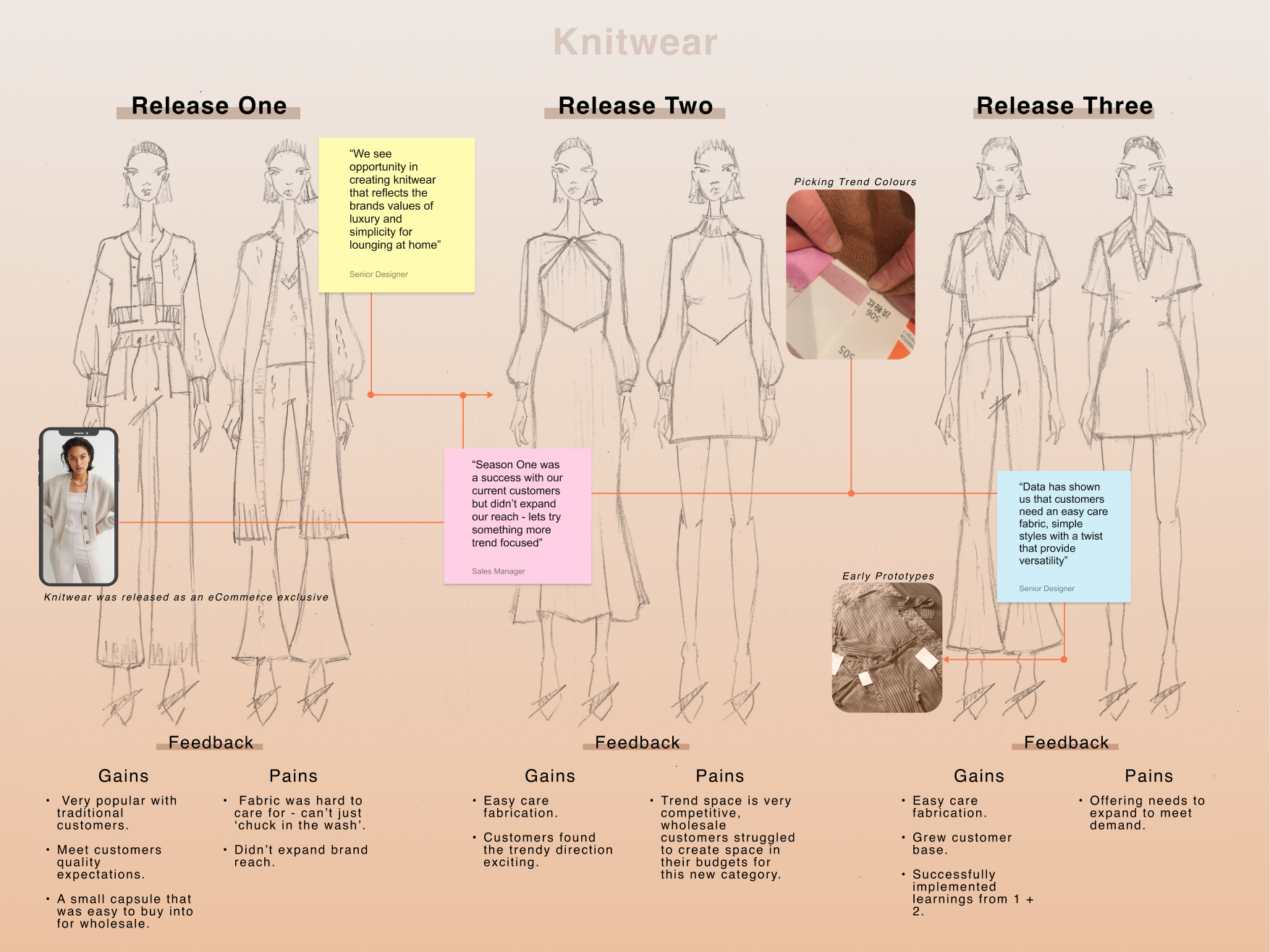Service Design
Transformation
Overview
Context
The fashion industry has experienced a dramatic shift from technological advancements, customer experience expectations, and evolving lifestyles. Businesses must adapt rapidly or be left behind.
I decided to “go undercover”, and influence change by leveraging my Service Design and Fashion Design skills to improve the customer experience and create products that resonated with customers whilst driving transformation.
The approach was inspired by the book ‘‘Undercover User Experience Design’ by Cennydd Bowles & James Box.’’
Duration
This project was ongoing; whilst working I used design tools and thinking to help bring everyone on the transformation journey.
Responsibilities
As Fashion Designer
Product concept & design, Prototyping, Product Production & Launch, Creative Direction
As ‘Undercover’ Design Researcher;
5 Why’s, Stakeholder Mapping, Conversational Interviews
‘Undercover’ Service Design Outcomes;
Personas, Concept Cards, Current State & Future State Vision
Problem
“How might we navigate the market volatility of Cost of Goods, using the solutions we find to future-proof the business and secure growth”
- Supply Chain & Margin -
“How might we successfully transition from a wholesale-focused model, into a direct-to-consumer one with a focus on eCommerce?”
- Changing Sales Landscape & Customer Expectations -
Solution & Outcomes
Digital Brand Experience
““Breaking down silos between marketing and design has meant that customer service enquiries are down, and our digital marketing is more effective. The personas created by design have been a catalyst for these changes”
Sales Strategy
“Expanding our product offering and changing our price point has created new leads and increased sales in both the wholesale and eCommerce channels.”
Fashion Product Design
‘’The brand's voice is more cohesive even though we have expanded the product offering and increased the price point to allow for a larger margin.
Customers are understanding and see the value in our product which reflects their lifestyles whilst offering distinct brand value.”
Starting Point - How the Team sees the Problem
Sales Manager
‘’Smaller wholesale customers cannot justify the rising price point, due to the challenges they have faced during the pandemic, they are losing market share to larger platforms like the Iconic’’
Fashion Designer
‘’The brand needs a clearer voice - more defined point of difference, better quality, and to connect with customers lifestyles more if we are to warrant a higher price point’’
Graphic Designer
‘’The product is beautiful, however, there seems to be a disconnect between the two sides of the brand; swimwear and resort wear, its leading to a confusing customer experience’’
Marketing & eCommerce
‘‘Customers are confused about what size they are, and some styles are missing imagery - like the back view! And the returns process seems complicated. It is not competitive against platforms like the Iconic’’
Finance
‘’The cost of fabric, labour, and freight is rising rapidly, and the market has become unpredictable since Covid began. We need to increase our sales price and therefore margin, so we can better weather these changes’’
Discovery
Mapping Stakeholders
One of the roadblocks encountered was that various stakeholders have conflicting needs and capabilities, and as such, it was important to map these in relation to the product to enable prioritisation and solidify strategies.
Feedback and Inquiries
The brand received a large volume of feedback from sales agencies, website customers, customer service calls, and via email. As each interaction was rich with information - containing a few different points, it was important to break out feedback into themes to create clear picture of the issues.
Using the 5 Why’s process then helped to clarify the underlying issues.
Competitor Analysis
Competitor analysis is an integral part of a Fashion Designer Role. This body of work was completed specifically to review where the competitors were placed regarding fabric composition and retail price against the Brand.
Development
Personas
An example of one of the four personas that were synthesised for this brand.
Concept Cards
These were developed every release to help set a new vision and goals for prototyping.
Customer Journey Map
The customer journey map borrows elements from a service blueprint because it is important to understand how internal actions are affecting the customer experience when designing fashion products.
Presenting Strategy
Within this context, presenting a current or future state journey map would’ve been inaccessible to many of the users within the organisation. The findings were presented in an appropriate format for the fashion industry by:
Embedding feedback into the language and mission statement of the brand to set a future vision.
Using positive language turns failings into opportunities as people are more responsive to this approach.
Prototyping
All prototypes and ideations begin with a sketch, from there fabrication and details are chosen, samples are then received. Parts of this process are repeated until the team are happy with the overall outcome.
At each stage, both internal and external stakeholders are consulted.
Frequently asked questions include:
How will this translate to a digital medium?
What is the most recent round of feedback and customer insights telling us?
How are sales trending?

Challenges
Change
External stakeholders such as marketing agencies initially resisted change because they were nervous to adopt new processes.
Integration
Merging new IT Systems with the existing was time consuming and labour intensive as there was no way to automate the data transfer.
Speed
Implementing customer feedback quickly was difficult given the physical and manual nature of fashion product, for example - how to exit old stock quickly?
Reflection
Scope
As the team grows, it would be advantageous to have a fashion designer work on singular product lines (either swim or resort wear) to narrow the scope of the design brief and allow a deeper exploration of the customers’ lifestyle.
Resilience
Continue to build resilience into the supply chain including bringing some manufacturing back to Australia.
This will increase transparency and reduce the impact of international events and political instability.
Digital Twin
What are the possibilities to further the digital experience, to more closely reflect the physical product?
How can we better navigate queries around fit, fabrication and stock replacement with both known technologies such as video and emerging animation tech?
Check out my other projects:

























